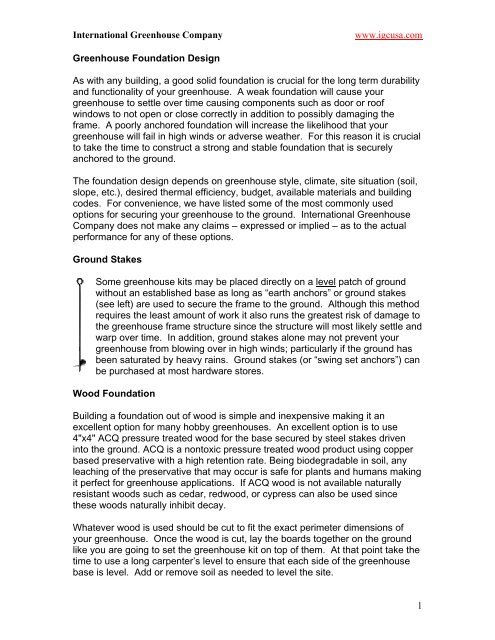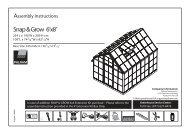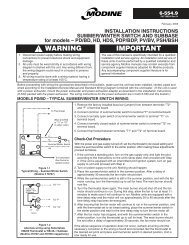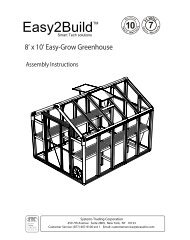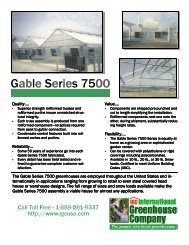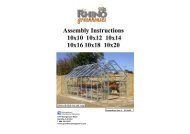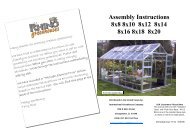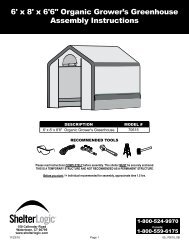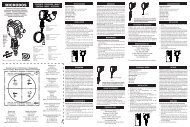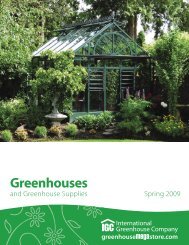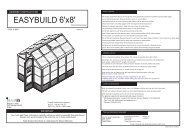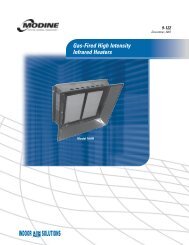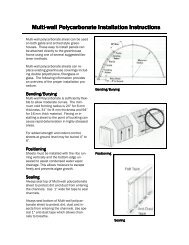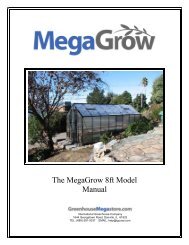International Greenhouse Company www.igcusa.com 1 Greenhouse ...
International Greenhouse Company www.igcusa.com 1 Greenhouse ...
International Greenhouse Company www.igcusa.com 1 Greenhouse ...
Create successful ePaper yourself
Turn your PDF publications into a flip-book with our unique Google optimized e-Paper software.
<strong>International</strong> <strong>Greenhouse</strong> <strong>Company</strong><br />
<strong>www</strong>.<strong>igcusa</strong>.<strong>com</strong><br />
<strong>Greenhouse</strong> Foundation Design<br />
As with any building, a good solid foundation is crucial for the long term durability<br />
and functionality of your greenhouse. A weak foundation will cause your<br />
greenhouse to settle over time causing <strong>com</strong>ponents such as door or roof<br />
windows to not open or close correctly in addition to possibly damaging the<br />
frame. A poorly anchored foundation will increase the likelihood that your<br />
greenhouse will fail in high winds or adverse weather. For this reason it is crucial<br />
to take the time to construct a strong and stable foundation that is securely<br />
anchored to the ground.<br />
The foundation design depends on greenhouse style, climate, site situation (soil,<br />
slope, etc.), desired thermal efficiency, budget, available materials and building<br />
codes. For convenience, we have listed some of the most <strong>com</strong>monly used<br />
options for securing your greenhouse to the ground. <strong>International</strong> <strong>Greenhouse</strong><br />
<strong>Company</strong> does not make any claims – expressed or implied – as to the actual<br />
performance for any of these options.<br />
Ground Stakes<br />
Some greenhouse kits may be placed directly on a level patch of ground<br />
without an established base as long as “earth anchors” or ground stakes<br />
(see left) are used to secure the frame to the ground. Although this method<br />
requires the least amount of work it also runs the greatest risk of damage to<br />
the greenhouse frame structure since the structure will most likely settle and<br />
warp over time. In addition, ground stakes alone may not prevent your<br />
greenhouse from blowing over in high winds; particularly if the ground has<br />
been saturated by heavy rains. Ground stakes (or “swing set anchors”) can<br />
be purchased at most hardware stores.<br />
Wood Foundation<br />
Building a foundation out of wood is simple and inexpensive making it an<br />
excellent option for many hobby greenhouses. An excellent option is to use<br />
4"x4" ACQ pressure treated wood for the base secured by steel stakes driven<br />
into the ground. ACQ is a nontoxic pressure treated wood product using copper<br />
based preservative with a high retention rate. Being biodegradable in soil, any<br />
leaching of the preservative that may occur is safe for plants and humans making<br />
it perfect for greenhouse applications. If ACQ wood is not available naturally<br />
resistant woods such as cedar, redwood, or cypress can also be used since<br />
these woods naturally inhibit decay.<br />
Whatever wood is used should be cut to fit the exact perimeter dimensions of<br />
your greenhouse. Once the wood is cut, lay the boards together on the ground<br />
like you are going to set the greenhouse kit on top of them. At that point take the<br />
time to use a long carpenter’s level to ensure that each side of the greenhouse<br />
base is level. Add or remove soil as needed to level the site.<br />
1
<strong>International</strong> <strong>Greenhouse</strong> <strong>Company</strong><br />
<strong>www</strong>.<strong>igcusa</strong>.<strong>com</strong><br />
When the foundation is level secure the timbers together at each corner using<br />
galvanized steel lag bolts. Lag bolts should be three or more inches longer than<br />
the first board it is screwed through to insure a proper hold. We re<strong>com</strong>mend<br />
laying some type of ground cover or weed barrier inside the <strong>com</strong>pleted base as<br />
an easy way to keep weeds from growing up inside your greenhouse while still<br />
allowing water to drain through the fabric.<br />
Once the wood foundation is <strong>com</strong>pleted it<br />
is crucial to make sure that your base is<br />
square. This is done by taking two<br />
diagonal measurements of the wood base<br />
(one from the front left corner to the back<br />
right corner and the other from the front<br />
right corner to the back left corner) and<br />
adjusting the wood until the two<br />
measurements are the same. Once the<br />
base is square you can anchor it to the<br />
ground using some type of earth anchor<br />
(see above) or ground stake (see right).<br />
The length of these anchors should be no<br />
less than 12” depending upon the type of soil<br />
(loose or <strong>com</strong>pacted) in your area.<br />
Now that you have finished building a<br />
foundation for your new greenhouse, the<br />
inside should be filled with 2 to 3 inches of<br />
pea gravel (see right), wood chips or some<br />
type of material that will allow for good<br />
drainage. Obviously, this task is much easier<br />
if it is done before securing the greenhouse<br />
2
<strong>International</strong> <strong>Greenhouse</strong> <strong>Company</strong><br />
<strong>www</strong>.<strong>igcusa</strong>.<strong>com</strong><br />
to your new wood base. Once your floor has been <strong>com</strong>pleted, your greenhouse<br />
kit can now be secured to the wood base per the manufacturer’s instructions.<br />
Concrete Piers or Perimeter Walls<br />
This type of concrete foundation is generally used with greenhouses that have<br />
been engineered to meet a particular load rating requirement.<br />
Under this method, a hole or “pier” is augured into the soil below the frost line for<br />
every greenhouse leg (there are two “legs” per greenhouse arch). The<br />
dimensions of this pier should follow the greenhouse manufacturer’s instructions<br />
or re<strong>com</strong>mendations. Lacking this re<strong>com</strong>mendation the size of the pier should<br />
be based on the overall size of the greenhouse and the type of soil (loose or<br />
<strong>com</strong>pact); however, it should never be less than 12” deep by 8” in diameter (see<br />
above). Obviously, the larger the pier the more stable and durable your<br />
greenhouse structure will be.<br />
It is important to check with your local building inspector to determine their<br />
requirements (if any) and to see if an inspection is required before any<br />
concrete is poured.<br />
3
<strong>International</strong> <strong>Greenhouse</strong> <strong>Company</strong><br />
<strong>www</strong>.<strong>igcusa</strong>.<strong>com</strong><br />
Once all holes are augured, each is filled with concrete with one of three<br />
structural <strong>com</strong>ponents suspended in the concrete pier:<br />
1. The leg or column of the greenhouse itself<br />
2. Some type of ground stake or earth anchor (see above diagram) that is<br />
then secured to the greenhouse frame<br />
3. Foundation or “J” bolts that are then secured to the greenhouse column<br />
Concrete Perimeter Footing and Wall<br />
For some kits another option to pouring piers is to form a continuous concrete<br />
“perimeter footing and wall”. The footing is formed and poured first by digging a<br />
trench in the soil to below the frost line and set your forms. The footing is usually<br />
twice as wide as the wall and equally as thick; however, we strongly re<strong>com</strong>mend<br />
that you check with your local building inspector to determine any sizing<br />
requirements and to see if an inspection is required before the footing is poured.<br />
Once the footing has hardened, go ahead and form up for the foundation wall.<br />
The wall height should be a minimum of 6 inches above grade as pictured below:<br />
Ground Level<br />
6" or 8" Foundation<br />
Footing (If required by local code)<br />
Depth as Required<br />
by local code or 18"<br />
Minimum<br />
The greenhouse base can be attached using concrete anchor bolts (see picture<br />
below) which are available at most home centers and hardware stores. Certain<br />
kits will require anchor bolts to be set for<br />
every arch; if not, space bolts within 1 ft.<br />
of each corner then space additional<br />
anchor bolts no more than 4 ft. apart<br />
along the perimeter of the frame.<br />
For greenhouses with fixed benches,<br />
one advantage of a perimeter footing<br />
(instead of a slab) is that concrete<br />
walkways can be poured between<br />
benches while the area underneath the<br />
benches can be filled with pea gravel for<br />
easy and efficient drainage.<br />
4
<strong>International</strong> <strong>Greenhouse</strong> <strong>Company</strong><br />
<strong>www</strong>.<strong>igcusa</strong>.<strong>com</strong><br />
Concrete Slab<br />
A concrete slab can provide a durable<br />
and easy to maintain base for a<br />
greenhouse. For most greenhouses,<br />
the floor should be several inches<br />
above the outside grade to prevent<br />
water from draining into your<br />
greenhouse (see picture left).<br />
Generally, the concrete foundation<br />
should be poured 1" longer and wider<br />
than the outside dimensions of the<br />
greenhouse. Although a 3” thick floor<br />
is adequate for most home<br />
greenhouses a 4” thick slab will help to minimize cracking. Regardless of the slab<br />
thickness the outside edges should be thicker to provide additional support and<br />
to reduce cracking from freezing weather.<br />
Select the Type of Mix<br />
There are many types of premixed masonry products available. Choosing one<br />
can be a confusing task. To simplify the selection process, narrow the field to<br />
three basic mixes.<br />
• Regular concrete mix is a mixture of sand, gravel, and Portland cement.<br />
Regular mix should be used in conjunction with wire remesh. Remesh<br />
adds stability to the concrete and helps ensure the pad doesn't develop<br />
large cracks. Regular mix works best when it's poured in warm weather.<br />
• High early strength concrete mix is best for cold weather pours. High<br />
early strength mixes have the same ingredients as regular mixes and an<br />
additive that shortens the setup time for the concrete. The shortened<br />
setup time helps the concrete cure before it can freeze in cold conditions.<br />
High early strength concrete also requires remesh.<br />
• Fiber-reinforced mixes have the same ingredients as regular mix and<br />
synthetic fibers that help strengthen the concrete's bond. Fiber-reinforced<br />
concrete can be poured without using wire remesh.<br />
Compare the properties of each mix to your needs and choose the one that suits<br />
your application best.<br />
Prepare the Site<br />
Determine the best location for the pad. Try to choose a location that is already<br />
level to reduce the need for digging.<br />
1. Mark the corners for the pad with stakes. Make sure the stakes are<br />
square. Set the stakes 6" back from each corner. Dig out the area inside<br />
5
<strong>International</strong> <strong>Greenhouse</strong> <strong>Company</strong><br />
<strong>www</strong>.<strong>igcusa</strong>.<strong>com</strong><br />
the stakes 6" deep. Most concrete pads are 4" deep; digging to 6" gives<br />
you enough room to lay a good base for the pad.<br />
2. Use a tamper to <strong>com</strong>pact the bottom of the hole. Fill in 2" of the bottom of<br />
the hole with gravel and fine sand. Compact the gravel and fine sand with<br />
a tamper.<br />
3. To promote water run-off,<br />
the pad needs a slight<br />
slope. One-quarter inch of<br />
drop per foot of length is<br />
usually sufficient.<br />
Determine which direction<br />
you want the water to<br />
drain, then stake and nail<br />
the first forming board on<br />
the high side of the pad.<br />
The stakes should be on<br />
the outside of the form to<br />
help steady the forming boards. Check the forming board to ensure that it<br />
is level from end to end. Install the second forming board at the low side of<br />
the pad. Use a line level to check for level between the first and second<br />
boards. The bubble in the level should read slightly toward the high side of<br />
the pad. Adjust the boards as needed. Stake and nail the last two forming<br />
boards. Backfill behind the boards with soil removed from the hole so they<br />
don't deflect (move) when the concrete is poured.<br />
4. Cover the bottom of the hole with 6 mil plastic. The plastic serves as a<br />
vapor barrier and helps prolong the life of the pad.<br />
5. If you aren't using fiber-reinforced concrete, cut and fit wire remesh into<br />
the form. Place the remesh on small blocks so that it rests at half the<br />
height of the pad.<br />
Pour the Concrete<br />
If you liked making mud pies, you're going to love pouring concrete. Have all your<br />
tools ready before you start mixing the first batch.<br />
1. Mix the concrete according to the manufacturer's instructions.<br />
2. Coat the insides of the forming boards lightly with cooking oil. The oil<br />
keeps the concrete from bonding to the boards and simplifies removing<br />
the forming boards later. Fill the form with wet concrete. Be sure to work<br />
the concrete into the corners.<br />
3. Screed the concrete with a 2x4 long enough to reach across the pad. Rest<br />
the 2x4 on top of the forming boards and work it back and forth in a<br />
sawing motion. As you work the board back and forth, pull it from one end<br />
6
<strong>International</strong> <strong>Greenhouse</strong> <strong>Company</strong><br />
<strong>www</strong>.<strong>igcusa</strong>.<strong>com</strong><br />
of the pad to the other. Make several passes with the screed board to<br />
even out the pad and knock down the high spots. Make several passes<br />
with the screed board to even out the pad and knock down the high spots.<br />
Fill any low spots with fresh concrete and screed the pad until the top is<br />
flush with the form.<br />
4. While the concrete is still wet, use a wooden or metal float to smooth the<br />
pad. Move the float in a semicircular motion along the top of the pad. Hold<br />
the leading edge of the float slightly above the concrete to avoid gouging<br />
the surface. As you float the surface, the gravel is forced down and excess<br />
water and air pockets rise to the top. Continue floating until the slab is<br />
smooth.<br />
5. After the concrete begins to set, use an edging tool along the sides of the<br />
pad. The edging tool breaks the pad loose from the form and <strong>com</strong>pacts<br />
the sides of the pad. For large pads, use a grooving tool every 6' to 8' to<br />
make control joints in the pad.<br />
6. Surface the pad. One of the most popular and simplest surfaces for<br />
concrete is the broom finish. Dampen the bristles of an ordinary street<br />
broom and drag it lightly across the pad's entire surface. The broom<br />
makes small ridges in the concrete and provides traction to the surface of<br />
the pad.<br />
Cure and Seal the Pad<br />
Proper curing and sealing promotes high strength and long life in the concrete.<br />
Follow these steps to protect your pad:<br />
1. Cover the pad with plastic for forty-eight hours to prevent it from flash<br />
drying on top.<br />
2. Uncover the pad and remove the forming boards. Allow the pad to<br />
continue curing according to the manufacturer's instructions.<br />
3. After the pad cures, apply concrete sealer to protect it.<br />
The above section on concrete slabs was provided courtesy of Lowes.<strong>com</strong><br />
Anchoring <strong>Greenhouse</strong> to Pad<br />
Once the pad is finished, the greenhouse can be secured to the pad using<br />
concrete anchoring bolts (see right). Using a special tool, these bolts are<br />
driven into the concrete leaving the threaded end of the bolt sticking up<br />
out of the slab. These bolts are then used to secure one or more<br />
structural <strong>com</strong>ponents of the greenhouse frame (typically the base or<br />
arches) to the concrete slab.<br />
7
<strong>International</strong> <strong>Greenhouse</strong> <strong>Company</strong><br />
<strong>www</strong>.<strong>igcusa</strong>.<strong>com</strong><br />
A typical concrete slab detail is listed below. Please note this is for reference<br />
only since every greenhouse kit is different.<br />
Glazing Material<br />
8mm Polycarbonate<br />
<strong>Greenhouse</strong> Column Post or Frame<br />
Foundation Bolts<br />
Concrete Slab on Grade<br />
Grade<br />
5-1/2"<br />
18"<br />
CONCRETE SLAB DETAIL<br />
12"<br />
When properly done, a concrete slab will provide a clean, durable floor for your<br />
greenhouse.<br />
8


